“I hope Vice President Jagdeep Dhankhar, Sonam Kapoor and Sourabh Phadke have created a complicated but clever plan to retrieve the Kohinoor during the King Charles coronation,” tweeted Ramesh Srivats a day before the coronation of King Charles and Queen Camilla. Minutes after the historic ceremony ended, another Twitter user wrote, “#Coronation done? Now are we getting the Kohinoor back? #justasking.” These tweets may be in jest but they draw attention to Britain’s cruel past. The priceless regalia and jewels displayed at the coronation ceremony have a murky, sometimes bloody history and the coronation has once again sparked the debate on whether Britain’s royal family should return these artefacts to their rightful owners. We take a look at some of the ‘British loot’ and the growing calls for these jewels and art pieces to be returned. Kohinoor The Kohinoor didn’t make an appearance at the coronation – it was originally a part of Queen Mary’s Crown that Queen Camilla opted for the ceremony. Perhaps, she chose to steer clear of the diamond owing to its murky past and the growing calls for it to be returned to India. In fact, shortly after the Queen Elizabeth II’s demise last year in September, Twitter lit up with many calling for the return of the Kohinoor— also spelled Koh-i-noor — which is part of the British crown jewels.
Last Week Tonight host John Oliver’s bit on the diamond, performed some five years, had also gone viral on all social media platforms with even actors such as Raveena Tandon jumping on to the bandwagon. The Kohinoor, which means “Mountain of Light,” was originally about 186 carats, and while its exact origins are unknown, it was most likely discovered in South India in the 13th century. According to the website of the UK’s royal palaces, the Kohinoor was unearthed from the Golconda mines in central southern India before it was handed to the British monarchy in 1849. Britain came in to possession of the Kohinoor when the East India Company took the jewel from deposed 10-year-old Maharaja Duleep Singh in 1849. Rumored to be cursed for men, it was initially worn as a brooch by Queen Victoria and later mounted in the crowns of Queen Alexandra and Queen Mary. It is currently set in a crown that was created for Queen Elizabeth, the Queen Mother, for her coronation as queen consort in 1937. She wore it again at the coronation of her daughter, Queen Elizabeth II, in 1953. It is on public display in the Jewel House at the Tower of London. [caption id=“attachment_12556962” align=“alignnone” width=“640”]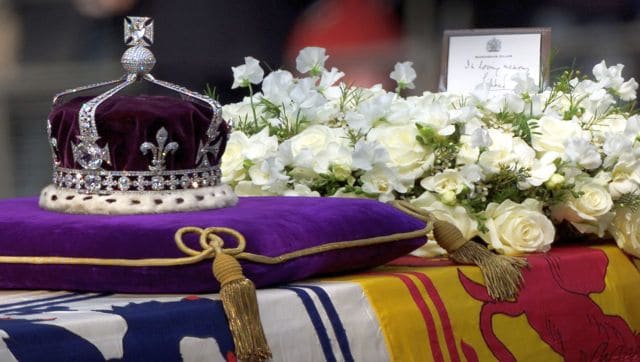 The Queen Mother’s coronation crown, featuring the controversial Kohinoor diamond. File image/Reuters[/caption] The diamond has been at the centre of political and legal controversy in India amid disputes over its ownership, with claims coming not just from India but
Pakistan
as well. Danielle Kinsey, an assistant professor of history with a focus on the history of 19th century Britain and empire at Carleton University in Ottawa, Ontario while speaking to NBC News observed that it is only a matter of time before the Kohinoor is surrendered. “To be purely pragmatic about it, at some point the monarchy will understand that keeping the diamond is more of a public relations liability for them than an asset,” she said to NBC News. “I think the same is true for many, many looted artefacts in Britain today and the institutions that house them. Also, it’s the right thing to do if the royal family is serious about making apologies for the ills of British imperialism and how they profited from it.” Other than the Kohinoor, The Guardian has also uncovered that the Royal Family had extracted other pieces of jewellery from India as trophies of conquest, including a “short necklace of four very large spinel rubies”, the largest of which is a 325.5-carat spinel that later came to be identified as the Timur ruby.
The Queen Mother’s coronation crown, featuring the controversial Kohinoor diamond. File image/Reuters[/caption] The diamond has been at the centre of political and legal controversy in India amid disputes over its ownership, with claims coming not just from India but
Pakistan
as well. Danielle Kinsey, an assistant professor of history with a focus on the history of 19th century Britain and empire at Carleton University in Ottawa, Ontario while speaking to NBC News observed that it is only a matter of time before the Kohinoor is surrendered. “To be purely pragmatic about it, at some point the monarchy will understand that keeping the diamond is more of a public relations liability for them than an asset,” she said to NBC News. “I think the same is true for many, many looted artefacts in Britain today and the institutions that house them. Also, it’s the right thing to do if the royal family is serious about making apologies for the ills of British imperialism and how they profited from it.” Other than the Kohinoor, The Guardian has also uncovered that the Royal Family had extracted other pieces of jewellery from India as trophies of conquest, including a “short necklace of four very large spinel rubies”, the largest of which is a 325.5-carat spinel that later came to be identified as the Timur ruby.
Great Star of Africa Besides calls from India to return the Kohinoor, the British monarchy is also facing calls from South Africa for the return of the
Great Star of Africa
or Cullinan I diamond. Known as the Great Star of Africa or Cullinan I, it is the biggest stone cut from the Cullinan diamond, which was discovered in South Africa in 1905 in a mine owned by its namesake, Thomas Cullinan, and is the largest gem-quality uncut diamond ever found. Today, the Great Star of Africa is mounted in the Sovereign’s Sceptre with the Cross, which King Charles carried at the coronation. According to the Royal Collection Trust, which oversees the royal collection of the British royal family, the Cullinan diamond was presented to King Edward VII (the British monarch at the time) in 1907, two years after its discovery in a private mine in South Africa’s old Transvaal province. [caption id=“attachment_12556982” align=“alignnone” width=“640”]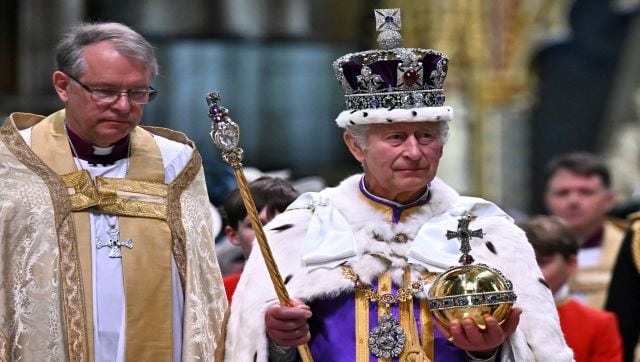 Britain’s King Charles III wearing the Imperial state Crown carrying the Sovereign’s Orb and Sceptre leaves Westminster Abbey after the Coronation ceremony. Reuters[/caption] However, many South Africans reject this narrative. A University of South Africa professor of African politics, Everisto Benyera, told CNN, “Our narrative is that the whole Transvaal and Union of South Africa governments and the concomitant mining syndicates were illegal. Receiving a stolen diamond does not exonerate the receiver. The Great Star is a blood diamond… The private (mining) company, the Transvaal government, and the British Empire were part of a larger network of coloniality.”
Britain’s King Charles III wearing the Imperial state Crown carrying the Sovereign’s Orb and Sceptre leaves Westminster Abbey after the Coronation ceremony. Reuters[/caption] However, many South Africans reject this narrative. A University of South Africa professor of African politics, Everisto Benyera, told CNN, “Our narrative is that the whole Transvaal and Union of South Africa governments and the concomitant mining syndicates were illegal. Receiving a stolen diamond does not exonerate the receiver. The Great Star is a blood diamond… The private (mining) company, the Transvaal government, and the British Empire were part of a larger network of coloniality.”
Catch all coverage from the King Charles’ Coronation ‘Not my King’ protests on Coronation Day: The Brits who want to dump the monarchy No uniform, no balcony appearance: How Harry was snubbed at coronation What are the crowns worn by King Charles and Queen Camilla? From Charles’ lover to mistress to queen, the fascinating life of Camilla King Charles’ Coronation: The British royal family’s line of succession explained
Activist Thanduxolo Sabelo was quoted as telling local media, “The Cullinan Diamond must be returned to South Africa with immediate effect. The minerals of our country and other countries continue to benefit Britain at the expense of our people.” A smaller diamond cut from the same stone, known as Cullinan II, is set in the Imperial State Crown which is worn by British monarchs on ceremonial occasions. Along with the sceptre, it is kept with the other crown jewels in the Tower of London. There’s also a petition being circulated asking for the Great Star of Africa to be returned and displayed in a South African museum. It has received the signatures of 8,000 people already. Elgin Marbles Greece has been demanding for the return of the Elgin Marbles since 1925. For those who don’t know, the Elgin Marbles, also known as the
Parthenon Marbles
, are a collection of different types of marble architectural decoration from the temple of Athena (the Parthenon) on the Acropolis in Athens. Today, they sit inside the British Musuem. [caption id=“attachment_12556992” align=“alignnone” width=“640”]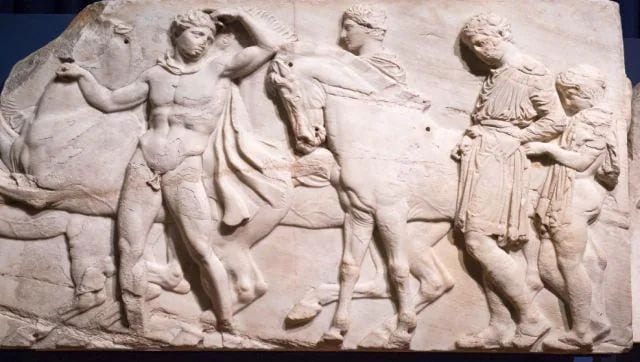 A section of marble frieze sculpture (438-432 BC) from the Parthenon in Athens, part of the collection that is popularly referred to as the Elgin Marbles, is displayed at British Museum. AFP[/caption] According to many media reports and archives in history, in 1803, Britain’s Lord Elgin allegedly removed the marbles from the Parthenon’s decaying walls in Greece and transported them to London. This is also the reason those precious marbles are called Elgin Marbles. The British Museum on their website state, “Lord Elgin was the British Ambassador to the Ottoman Empire and successfully petitioned the authorities to be able to draw, measure and remove figures. “He was granted a permit (firman), and between 1801 and 1805 acting under the oversight of the relevant authorities, Elgin removed about half of the remaining sculptures from the ruins of the Parthenon. He also obtained permission to have removed sculptural and architectural elements from other buildings. “All of Elgin’s collection of antiquities was then transported to Britain. His actions were thoroughly investigated by a Parliamentary Select Committee in 1816 and found to be entirely legal, prior to the sculptures entering the collection of the British Museum by Act of Parliament.” Greece has been demanding for the return, with even actor George Clooney and his wife Amal campaigning on their behalf. In July, the deputy director of the British Museum proposed a “Parthenon partnership” with Greece that could see the marbles returned to Athens after more than 200 years. Rosetta Stone As Indians call for the return of the Kohinoor, the Egyptians want to bring back the Rosetta Stone, which is currently on display at the British museum. The Rosetta Stone, a granodiorite stele, has unlocked the mysterious hieroglyphic script of ancient Egypt. It is perhaps the most famous piece of rock in the world. [caption id=“attachment_12557002” align=“alignnone” width=“640”]
A section of marble frieze sculpture (438-432 BC) from the Parthenon in Athens, part of the collection that is popularly referred to as the Elgin Marbles, is displayed at British Museum. AFP[/caption] According to many media reports and archives in history, in 1803, Britain’s Lord Elgin allegedly removed the marbles from the Parthenon’s decaying walls in Greece and transported them to London. This is also the reason those precious marbles are called Elgin Marbles. The British Museum on their website state, “Lord Elgin was the British Ambassador to the Ottoman Empire and successfully petitioned the authorities to be able to draw, measure and remove figures. “He was granted a permit (firman), and between 1801 and 1805 acting under the oversight of the relevant authorities, Elgin removed about half of the remaining sculptures from the ruins of the Parthenon. He also obtained permission to have removed sculptural and architectural elements from other buildings. “All of Elgin’s collection of antiquities was then transported to Britain. His actions were thoroughly investigated by a Parliamentary Select Committee in 1816 and found to be entirely legal, prior to the sculptures entering the collection of the British Museum by Act of Parliament.” Greece has been demanding for the return, with even actor George Clooney and his wife Amal campaigning on their behalf. In July, the deputy director of the British Museum proposed a “Parthenon partnership” with Greece that could see the marbles returned to Athens after more than 200 years. Rosetta Stone As Indians call for the return of the Kohinoor, the Egyptians want to bring back the Rosetta Stone, which is currently on display at the British museum. The Rosetta Stone, a granodiorite stele, has unlocked the mysterious hieroglyphic script of ancient Egypt. It is perhaps the most famous piece of rock in the world. [caption id=“attachment_12557002” align=“alignnone” width=“640”]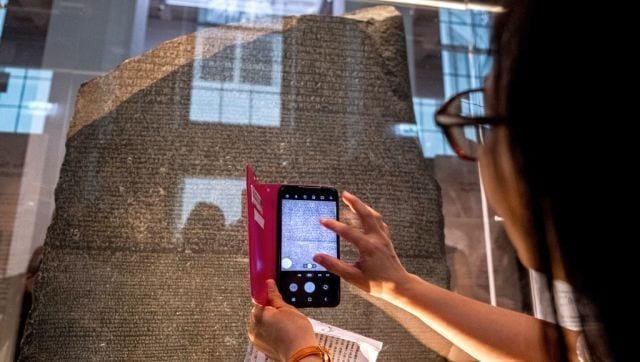 A visitor uses a phone to take pictures of the Rosetta Stone at the British Museum in London. The Rosetta Stone has been housed in the British Museum since 1802. AFP[/caption] As the story goes, the Rosetta Stone was found in Memphis, Egypt in 1799 by a French military officer before being seized by British forces in Alexandria and shipped to England two years later. In 1802, the stele, which enabled hieroglyphs to be deciphered, was given to the British Museum. Since then, the stone has been on display at the museum, with only one break during the World War I, in 1917, when the museum moved important objects to prevent damage from heavy bombing in London. Egyptian archaeologist Zahi Hawass has initiated a campaign for the return of the atefact. “The Rosetta Stone is the icon of Egyptian identity. The British Museum has no right to show this artefact to the public,” he was quoted as telling The National, adding, “They left Egypt completely illegally and they should come back,” he said. Benin Bronzes The Benin Bronzes are a group of thousands of objects that were taken from the kingdom of Benin, in what is now Nigeria, in 1897. (Their exact number is unknown, though it is believed to exceed 3,000.) These objects — including figurines, tusks, sculptures of Benin’s rulers, and an ivory mask —were looted by British troops, and have since been dispersed around the world, with the bulk of the works now residing with state museums in Europe. But, how did the British come into their possession. It is said that the death of James Phillips, an unarmed British explorer, on the orders of Benin’s ruler Oba Ovonramwen caused the loot. [caption id=“attachment_12557012” align=“alignnone” width=“640”]
A visitor uses a phone to take pictures of the Rosetta Stone at the British Museum in London. The Rosetta Stone has been housed in the British Museum since 1802. AFP[/caption] As the story goes, the Rosetta Stone was found in Memphis, Egypt in 1799 by a French military officer before being seized by British forces in Alexandria and shipped to England two years later. In 1802, the stele, which enabled hieroglyphs to be deciphered, was given to the British Museum. Since then, the stone has been on display at the museum, with only one break during the World War I, in 1917, when the museum moved important objects to prevent damage from heavy bombing in London. Egyptian archaeologist Zahi Hawass has initiated a campaign for the return of the atefact. “The Rosetta Stone is the icon of Egyptian identity. The British Museum has no right to show this artefact to the public,” he was quoted as telling The National, adding, “They left Egypt completely illegally and they should come back,” he said. Benin Bronzes The Benin Bronzes are a group of thousands of objects that were taken from the kingdom of Benin, in what is now Nigeria, in 1897. (Their exact number is unknown, though it is believed to exceed 3,000.) These objects — including figurines, tusks, sculptures of Benin’s rulers, and an ivory mask —were looted by British troops, and have since been dispersed around the world, with the bulk of the works now residing with state museums in Europe. But, how did the British come into their possession. It is said that the death of James Phillips, an unarmed British explorer, on the orders of Benin’s ruler Oba Ovonramwen caused the loot. [caption id=“attachment_12557012” align=“alignnone” width=“640”]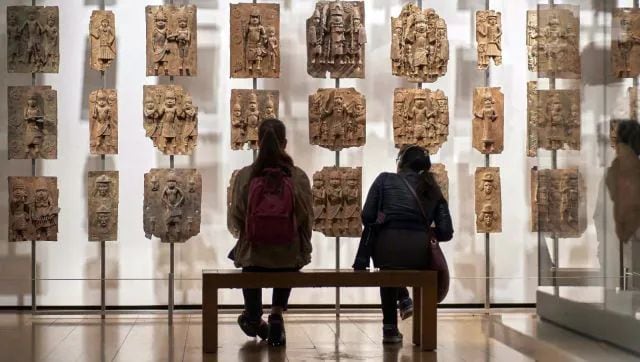 he Benin Bronzes are a group of thousands of objects that were taken from the kingdom of Benin, in what is now Nigeria, in 1897. These objects have since been dispersed around the world, with the bulk of the works residing at the British Museum. Image Courtesy: britishmuseum.org[/caption] Artnews.com reports that to avenge Philips’ death, the British Empire sent troops to steal artifacts from the kingdom, and they walked away with thousands of priceless objects. Today, Nigerians have been demanding that the figurines be returned to them, as they are a window into the African art of those times and it’s just unfair that the locals have to travel to London if they want to take a look at them. With inputs from agencies Read all the Latest News
, Trending News
, Cricket News
, Bollywood News
, India News
and Entertainment News
here. Follow us on
Facebook
,
Twitter
and
Instagram
.
he Benin Bronzes are a group of thousands of objects that were taken from the kingdom of Benin, in what is now Nigeria, in 1897. These objects have since been dispersed around the world, with the bulk of the works residing at the British Museum. Image Courtesy: britishmuseum.org[/caption] Artnews.com reports that to avenge Philips’ death, the British Empire sent troops to steal artifacts from the kingdom, and they walked away with thousands of priceless objects. Today, Nigerians have been demanding that the figurines be returned to them, as they are a window into the African art of those times and it’s just unfair that the locals have to travel to London if they want to take a look at them. With inputs from agencies Read all the Latest News
, Trending News
, Cricket News
, Bollywood News
, India News
and Entertainment News
here. Follow us on
Facebook
,
Twitter
and
Instagram
.
)